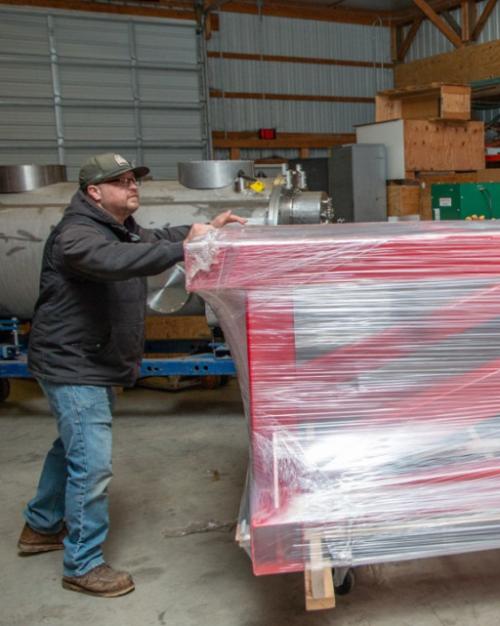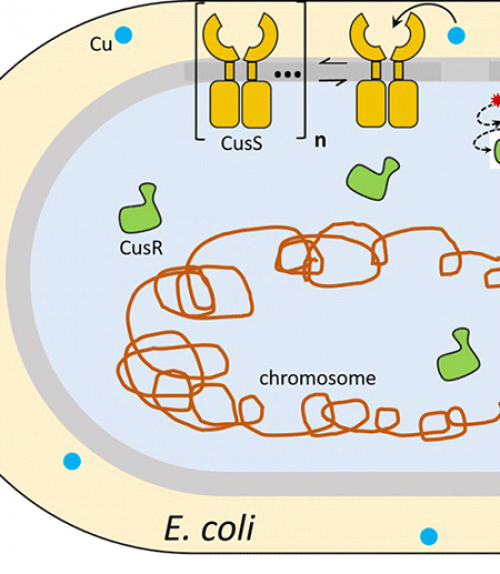Bacteria have a cunning ability to survive in unfriendly environments.
For example, through a complicated series of interactions, they can identify – and then build resistance to – toxic chemicals and metals, such as silver and copper. Bacteria rely on a similar mechanism for defending against antibiotics.
Cornell researchers combined genetic engineering, single-molecule tracking and protein quantitation to get a closer look at this mechanism and understand how it functions. The knowledge could lead to the development of more effective antibacterial treatments.
The team’s paper, “Metal-Induced Sensor Mobilization Turns on Affinity to Activate Regulator for Metal Detoxification in Live Bacteria,” published May 28 in Proceedings of the National Academy of Sciences.
“We were really interested in the fundamental mechanism,” said Peng Chen, the Peter J.W. Debye Professor of Chemistry in the College of Arts and Sciences and the paper’s senior author. “The broader concept is that once we know the mechanism, then perhaps we can come up with better or alternative ways to compromise bacteria’s ability in defending against toxic chemicals. That will hopefully contribute to designing new ways of taming bacterial drug resistance.”
The bacteria’s resistance is actually a tag-team operation, with two proteins working together inside the cell. One protein (CusS), in the inner membrane, senses the presence of the chemical or metal and sends a signal to a regulator protein (CusR) in the cytosol, or intercellular fluid. The regulator protein binds to DNA and activates a gene that generates transport proteins, which purge the toxin from the cell.
Typically, scientists analyze these functions by using biochemical assays that remove the protein from the cell. However, that process prevents the scientists from observing the proteins in their native environment, and certain details, such as the spatial arrangement between proteins, have remained murky.
For a deeper analysis, Chen’s team used single-cell imaging, whereby they tagged individual proteins in living E. coli with a fluorescent signal and imaged the proteins one at a time, tracking their motions. The procedure yielded millions of images and, ultimately, a finely detailed, qualitative map of the proteins’ movement.
The team was specifically interested in the activities of sensor proteins, which come in two varieties – those that cluster together and those that move around the inner membrane. The researchers found that when E. coli encounters copper, the free-floating, mobile variety of the sensor proteins increase in number while the clustered faction are reduced. The mobilized sensor proteins interact with the regulator protein and initiate a complex series of steps – from binding the copper to binding and breaking down the compound ATP, which eventually lead to gene expression – that will flush the metal from the cell.
“One of the unknowns among the steps is at what point the sensor protein forms a protein-protein complex with the regulator protein,” Chen said. “We found that as soon as the sensor binds copper, it already causes its recruitment of this regulator protein. This occurs really, really early in this sequence of events.”
The early recruitment provides a functional advantage by initiating the sequence and quickly speeding it along before the sequence has time to decay. Chen likens this strategy to a game of hot potato.
“If I hold a hot potato and want to give it to you, I don’t want to hold the potato before calling you over,” Chen said. “I want you to be right next to me, so I can immediately pass it to you. Otherwise, the hot potato becomes cold. Or it’s too hot, so I have to throw it away. In chemical terms, basically that species would decay or transfer to something else.”
The paper’s lead authors were postdoctoral researcher Bing Fu, former postdoctoral researcher Kushal Sengupta and doctoral student Lauren Genova, all from the Chen lab. Other contributors were Ace George Santiago, Ph.D. ’16; Won Jung, Ph.D. ’18; former postdoctoral researcher Lukasz Krzemiński; and doctoral students Udit Kumar Chakraborty and Wenyao Zhang.
The research was supported by the National Institutes of Health and the Army Research Office.
Read the story in the Cornell Chronicle.




